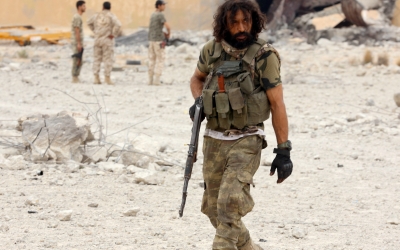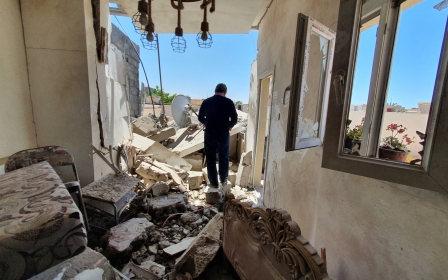GNA militias run riot in Libya's Tarhuna after LNA retreat

Forces loyal to Libya’s Government of National Accord (GNA) have carried out a campaign of arrests, arson and looting across Tarhuna after seizing the western town from Khalifa Haftar’s Libyan National Army (LNA). GNA fighters have also been accused of extrajudicial killings.
GNA fighters entered the mountain town on Friday, after troops from the LNA, the military wing of Libya’s eastern-based government, had suddenly withdrawn in the early hours of the morning.
It was a moment that many locals had been dreading during the preceding fortnight - the LNA had suffered repeated setbacks and started pulling back from long-held positions on Tripoli’s outskirts, as Haftar’s yearlong offensive on the capital collapsed.
'The GNA militias had been saying on Facebook, as far back as September last year, that they would turn Tarhuna into a second Tawergha and that’s exactly what they are doing now'
- Khalil, shopkeeper
“The GNA militias had been saying on Facebook, as far back as September last year, that they would turn Tarhuna into a second Tawergha and that’s exactly what they are doing now,” shopkeeper Khalil, who lives in a town near Tarhuna, told Middle East Eye. “They will punish us all for supporting the LNA.”
The entire population of Tawergha, a town 100km east from Tarhuna, was uprooted by forces from Libya’s third city of Misrata after the 2011 uprising that overthrew longterm Libyan leader Muammar Qaddafi. The town was virtually razed to the ground. Residents only started returning in 2018 but have struggled to rebuild.
Amnesty International had already warned of retaliation attacks in newly captured Tarhuna, citing the “Tawergha” threat and previous violations carried out following the capture of other formerly LNA-held towns. During the year-long Battle for Tripoli, both sides have been accused of war-crimes.
Two separate sources in Tarhuna told MEE that extrajudicial killings had been carried out, although such deaths have yet to be independently verified.
Widespread looting
Since retaking Tarhuna, GNA forces have carried out looting and arson.
“Everything you hear about what is happening in Tarhuna is true - the killings, the looting and the burning,” said local resident and oil worker Mohamed, who has fled to the outskirts of the town.
“Everything is burned and destroyed, and everything has been stolen. We expect that anyone associated with the LNA who is captured will be assassinated, and there have already been many arrests. I am very upset with the GNA that they haven’t yet sent any additional forces to pacify these militias, when everyone knows exactly what’s happening here.”
Information from Tarhuna residents themselves has trickled out slowly, as the area had largely fallen silent after communications were cut and GNA fighters removed two telecommunications towers, wiping out local internet coverage.
But the GNA forces themselves have been widely self-publicising their deeds via an almost unending series of videos and photos posted on social media sites since Friday.
Many Libyans, largely confined to their homes during an ongoing lockdown and curfew imposed to slow the spread of coronavirus, spent the weekend glued to their devices watching as the events in Tarhuna unfolded online.
Footage circulated on social media include the local shopping centre being burned down, GNA fighters triumphantly burning the gate of Tarhuna and another urinating on a nearby plaque commemorating local martyrs.
“Most Libyans feel very sad and ashamed by what is happening in Tarhuna, which is not acceptable behaviour even in wartime,” social media activist Seraj told MEE.
“These guys have given themselves a very bad reputation by filming themselves doing all these awful things and then posting them on Facebook.”
Shopkeeper Khalil, who had fled to Tarhuna wrongly believing it would be safer than his own home, described watching convoys of vehicles piled high with goods leaving the town.
“They took everything, even washing machines, fridges, freezers, TV screens and car tyres, and seeing this made me very angry and upset,” he said.
His claims were supported by extensive photos and video footage circulated on social media showing trucks piled high with white goods, and stolen civilian cars with the names of the militias that had taken them spray-painted across the bonnets.
“The GNA is denying that this is happening in Tarhuna, but two days ago when I was there, I saw it with my own eyes,” said Khalil. “A relative told me that militia members entered a family’s house and took the gold earrings from the ears of the little girls. They are savages.”
He said fights had even broken out among rival GNA militias themselves, over who had claim to the stolen property.
The GNA interior ministry on Sunday issued a statement calling on military and security forces in "liberated areas" to protect civilian lives and their property, vowing to hold transgressors to account, whatever their rank.
Looting was on such a scale that empty cargo trucks were reportedly brought in to carry away the plunder, which included entire flocks of sheep, the livelihood of many in this rural part of Libya.
Property belonging to the late LNA-supporting local commander Mohsin al-Kani, who was killed in September last year in a precise aerial attack widely believed to beyond the scope of either of Libya’s air forces, has been particularly targeted.
Footage circulated on social media showed his expansive family home being fired on, and local resident Mohamed told MEE that the cemetery where his body was buried was torched, saying it was not known whether Kani’s corpse had also been exhumed.
Kani kept a small zoo of African animals adjacent to his home, which included a lion and a herd of gazelles.
“That lion was quite famous because Libyans love lions and there were photos of Kani petting the lion and calming it down shared online a year ago,” said Seraj.
“The GNA fighters shot and killed the lion and also killed the gazelles, roasted their meat and ate them. In Libya, we are fond of gazelles as pets and it’s culturally unacceptable to eat them.”
Displacement crisis
The withdrawal of LNA forces from Tarhuna prompted hundreds of families to flee eastwards, an option beyond the reach of those unable to pay for fuel which, for the past few weeks, has been retailing locally at 100LYD ($71) for 20 litres.
“Many families have been arriving in [the central coastal town of] Bin Jawad and, although we’re scared of coronavirus, locals have been greeting them in the street with food and water because it’s 40 degrees here,” said resident Abdul.
He added that the local authorities had temporally suspended a curfew currently restricting shop opening hours, to enable fleeing people to purchase essential items.
“We have opened our schools for their accommodation and people are doing their best with donations of food and drinks, but really we are receiving a huge wave of people, so it’s not easy,” he said.
Libyan TV channels reported on Monday that over 20,000 people had already fled Tarhuna, adding to an estimated existing 373,709 internally displaced Libyans.
The UN’s refugee agency UNHCR is aware of considerable fresh displacement and has convoys with food and non-food items already prepared, pending security clearance to move.
Cycle of revenge
Backing either side in Libya’s protracted civil war has long come with the risk of future retaliation, but it was always going to be particularly acute for Tarhuna, due to long-standing local tensions.
Allied with Libya’s third city of Misrata for a planned attack on Tripoli in late 2018 aimed at ridding the capital of local militias believed to be controlling the country’s Central Bank, the relationship soured when Tarhuna militias requested more weapons and ammunition.
The Misratans, suspecting many in the city of being pro-Gaddafi, then stopped munitions supplies altogether. Within a few months, much to Misrata’s indignation, Tarhuna’s militias had pledged support for Haftar’s LNA in a new battle for Tripoli, pitting themselves against the Misratan forces (by then supporting the GNA against the LNA) with whom they had previously been fighting alongside.
This grievance has not been forgotten and is believed to have played a role in the severity of the looting and destruction in the town.
However much the LNA’s popularity may have plummeted after their sudden withdrawal from Tarhuna, the GNA have been cast in an even poorer light.
Haftar’s forces, which are backed by the UAE, Egypt and Russia, have been waging an offensive on Tripoli and its environs since April 2018. But the LNA lines have collapsed in recent days as Turkish-backed GNA forces swiftly advanced into areas abandoned by Haftar’s fighters.
LNA spokesperson Ahmed al-Mismari said the decision to withdraw from the town was to spare civilians from suffering under a protracted war, though Haftar’s forces had found themselves exposed as allied Russian mercenaries pulled back to Libya’s south.
Widely believed locally to be part of a behind-the-scenes deal between the rival sides’ international backers, the withdrawal meant the GNA forces were able to retake Tarhuna largely without fighting.
But the subsequent human rights abuses have stoked fears that a ceasefire deal has been undermined and the path has been paved for future revenge attacks.
“They have made a grave mistake turning Tarhuna into a second Tawergha. The Tawergha are just a small tribe who lived mostly in one place, but the tribes comprising Tarhuna makes it one of the biggest in Libya, numbering approximately one million people,” explained a Sirte resident with high-level tribal contacts.
“Almost one third of Tripoli residents are from Tarhuna's tribes and this unacceptable behaviour by the GNA forces will shatter social cohesion.”
He predicted that revenge, sooner or later, was inevitable, and that it would be particularly aimed at militias from Mistrata, who have boasted of taking the lead in retaking Tarhuna.
“Although many people from Tarhuna have fled, they will come back and there will be revenge,” he said.
“It is possible to offer compensation for property losses, but killings cannot be compensated except by more killing. This is the Arab way, the tribal way, and it is just how it is.”
Middle East Eye propose une couverture et une analyse indépendantes et incomparables du Moyen-Orient, de l’Afrique du Nord et d’autres régions du monde. Pour en savoir plus sur la reprise de ce contenu et les frais qui s’appliquent, veuillez remplir ce formulaire [en anglais]. Pour en savoir plus sur MEE, cliquez ici [en anglais].







